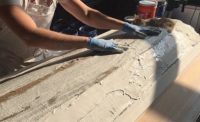Molding Theory
PLASTER GETS ARCHITECTURAL! EXPLORING THE VOCABULARY, GRAMMAR AND COMPOSITION OF THE CLASSICAL PLASTERER.






The art of plastering is divided into two major fields of employ. Rendering is fundamental. A plaster apprentice first learns to tend, to prepare various binders such as gypsum, lime or cement into a workable plaster mix. As he progresses, he then learns how to “square” a room, establishing centerlines, benchmarks and grounds. His education culminates in mastering the art of rendering plaster; applying plaster in successive coats until he achieves a smooth and planar surface.
Many plasterers make a good living with rendering skills alone. However, once mastery of rendering has been achieved, a plasterer may progress on to run molding work. As is the case with all molding mediums, plaster molding is an art strongly allied to the field of architecture. A number of treatises, books and papers have been published from the Renaissance through the 20th century on the theory of molding design.
I will attempt to briefly present three ways of considering molding design using metaphors of language:
- Vocabulary
- Grammar
- Composition
As is the case with language, we can think of each section as a progression building towards higher levels of sophistication.
Vocabulary
In language, vocabulary is the set of words that are familiar to a person or group of persons. It is a fundamental of speech and communication. To create intelligible moldings, architects and artisans also have need for a common vocabulary.
The vocabulary of moldings can be defined as the most basic elements found within a molding. The shape of a given molding is determined by its profile. In the case of plaster, this profile is in the form of a knife that ‘cuts’ the hardening plaster. A given profile will contain several ‘elements’ or individual shapes that make up the profile. These individual shapes each have a specific geometry that can be identified. Our molding vocabulary can likewise be thought of as the pure geometric forms found within a molding.
We can group individual elements in a profile by their geometry. Below are a few examples sorted under the four principal geometries:
Straight: fillet, fascia, chamfer
Concave: cavetto, scotia, apophyge
Convex: ovolo, torus, astragal
Compound/Complex: cyma recta, cyma reversa, beak
Grammar
Language needs to have rules and structure, otherwise known as grammar. Just as individual words or vocabulary perform a function (noun, verb, adjective, etc.) within a sentence, individual molding elements manifest an architectural function within a profile. Let’s consider each of the five of the principal architectural functions of moldings individually.
Terminating: cavetto, cyma recta
Terminating elements are often found at the top of a cornice or other crowning feature. Because most of its form is void, it conveys lightness but an inability to support a load, so therefore is not generally appropriate lower in a profile.
Supporting: ovolo, echinus
In direct contrast to the aforementioned terminating elements are supporting elements. The robust, sturdy shapes of these elements imply a capacity to support significant weight above it. Supporting elements are prominently featured as bed moldings where they appear to support a projecting crown.
Binding: torus, thumb, astragal
As the name implies binding elements encircle an object as if it were holding it together. Various half round elements such as tori or astragals are commonly found at necks and bases of columns.
Separating: bead, fillet, scotia
Separating elements typically are smaller in scale to binding elements. As such, beads and fillets create division and clarify transitions from one larger element to the next.
Prone/Transitional: cavetto, cyma reversa
Transitions from vertical wall surfaces to horizontal floor surfaces indicate a transfer of weight. Prone moldings can simultaneously provide a graceful translation from one vertical plane to the next, such as the bottom of a wall or column to the top of a base or plinth.
Composition
Upon mastery of vocabulary and grammar we have all the tools necessary to compose a molding profile or even an entire elevation. Of course, we’re faced with the traditional challenges of any author of creating an intriguing story. Here are a few principles to keep in mind in molding composition.
Harmony is very important both within a molding and throughout an entire elevation. One of the most harmonizing factors is to maintain a common facial angle common to all moldings. In Roman and Renaissance architecture 45° was a common angle whereas 60° was used more often by the ancient Greeks. Too much harmony, such as repeating the same elements at the same scale, can lead to monotony.
Rhythm can provide welcome contrast. Alternating straight and curved elements is one way of providing rhythm. Contrasting concave and convex curves is also very effective. Radial curves provide a very even gradation of shadow whereas curves of conic sections (parabola, hyperbolae and ellipses) provide sharper transitions and more contrast. For many theorists the study of the shadow created is more important than the profile itself.
Dominance is a principle that can define the feel of a molding, elevation or an entire building. The addition of 'ears' or an over door to an entry can indicate its hierarchy over lesser doorways. Dominance can also be achieved by use of scale, exaggerating a supporting or terminating element throughout the composition i.e., to establish an overall feeling of delicacy or ruggedness.
A Classical Example
The Attic Base is the most used column base in Classical and Gothic architecture and is found in other vernacular architectural styles around the world. Let’s break it down to its constituent elements and see how much of what we have previously considered applies to the Attic base.
The vocabulary or individual elements of the Attic Base and their grammatical role are as follows from top to bottom:
- Fillet – separating
- Torus – binding
- Fillet – separating
- Scotia – separating/prone
- Fillet – separating
- Torus – binding
The composition manifests principles of harmony, rhythm and dominance. Let’s break it down:
- All three fillets are the same height creating a harmonious relation. Also, the tori are both perfect half rounds; although by being of different scales they avoid monotony.
- The two middle fillets combine with the scotia to provide contrast against the tori establishing a rhythm of binding, separating, binding. The scotia is slightly prone allowing the bottom torus to be larger.
- The two tori definitely dominate the overall composition, firmly establishing the Attic Base as a binding molding.
Conclusion
This article is a brief review of a very involved study refined over thousands of years. However, even a basic understanding of vocabulary, grammar and composition will allow anyone to “read” and appreciate many of the great architectural works of Western civilization.
Looking for a reprint of this article?
From high-res PDFs to custom plaques, order your copy today!




.jpg?height=200&t=1625764395&width=200)







